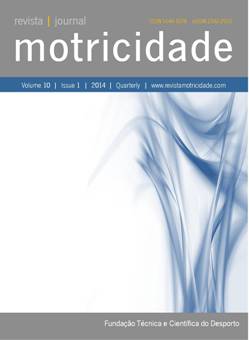Association between levels of physical activity and common mental disorder in university students
DOI:
https://doi.org/10.6063/motricidade.2125Abstract
This study aimed to investigate the association between physical activity level (PAL) and common mental disorders (CMD) in students of health programs at a federal university (UFAL). The cross-sectional study comprised a sample of 220 students of the first two and last two periods of each program (65.9% women; 34.1% men). We used the International Physical Activity Questionnaire (IPAQ), the Self - Reporting Questionnaire (SRQ-20), and sociodemographic questionnaire. The odds ratios were calculated (OR: IC95%, p< 0.05). It was verified a positive CMD classification in 43.2% of the sample. A higher percentage of inactive students with TMC (67.4%) than physically active students (32.6%) was observed, with significant risk (OR= 3.202, IC95%: 1.83−5.60). Undergraduate students in the first periods were more active (55.3%) compared to counterparts (41.5%), with a significant protective factor (OR= 0.575, IC95%: 0.337−0.980). Pharmacy had a higher prevalence of TMC (24.20%) and Nutrition had the lowest (9.50%). Pharmacy had a higher prevalence of physically active students (68.40%), while Nursing had a higher prevalence of inactive students (58.30%). It was observed that physically inactive students had three times more chance to develop TMC when compared with physically active students, showing that graduation can be a period of risk for the university, whether due to various stressors, lack of healthy habits, poor and/or inadequate practice of physical activity during this period.
Downloads
Published
Issue
Section
License
The authors of submitted manuscripts must transfer the full copyright to Journal Motricidade / Desafio Singular Editions. Granting copyright permission allows the publication and dissemination of the article in printed or electronic formats and copyrights start at the moment the manuscript is accepted for publication. It also allows Journal Motricidade to use and commercialize the article in terms of licensing, lending or selling its content to indexation/abstracts databases and other entities.
According to the terms of the Creative Commons licence, authors may reproduce a reasonable number of copies for personal or professional purpose but without any economic gains. SHERPA/RoMEO allows authors to post a final digital copy (post-printing version) of the article in their websites or on their institutions' scientific repository.


